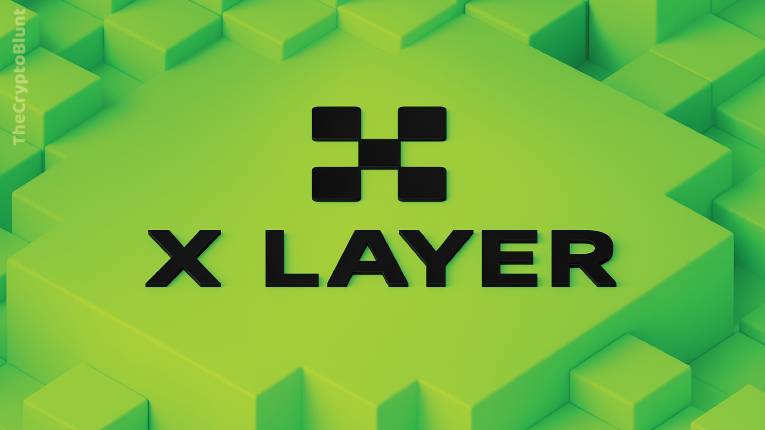One such promising development is the X Layer Ecosystem, spearheaded by the major cryptocurrency exchange OKX. X Layer isn’t just another blockchain; it’s a dedicated effort to build a scalable, efficient, and user-friendly environment for decentralized applications (dApps), connecting seamlessly with both the OKX exchange and the broader Ethereum network. It leverages cutting-edge Zero-Knowledge (ZK) Proofs and is built using Polygon’s Chain Development Kit (CDK), aiming to provide near-instant transaction finality, unified liquidity, and a robust platform for developers and users alike.
This comprehensive article is your gateway to understanding the X Layer Ecosystem. We’ll start by revisiting the fundamental concepts of cryptocurrency, blockchain, decentralization, and smart contracts, providing you with a solid foundation. We’ll then delve into the specifics of X Layer’s architecture, its role as a Layer 2, how it utilizes ZK technology, and its connection to the OKX platform.
We’ll explore the real-world problems it aims to solve, directly confront common misconceptions about Layer 2s and ZK technology, and offer a practical, beginner-friendly perspective on how you can safely begin your journey within this evolving ecosystem. Our goal is to provide a clear, no-nonsense introduction for absolute beginners, empowering you to understand X Layer’s potential to redefine how we interact with Web3.
The Digital Bedrock Revisited: Core Concepts for X Layer
To truly appreciate the X Layer Ecosystem, it’s vital to first understand the fundamental building blocks of the blockchain world. These concepts are the very foundation upon which X Layer is built.
1. Cryptocurrency: Digital Money, Decentralized Control
A cryptocurrency is a form of digital or virtual money secured by cryptography, making it highly secure and resistant to counterfeiting. Unlike traditional currencies controlled by central banks, cryptocurrencies operate on decentralized networks. This means no single entity has the power to manipulate its value or censor transactions beyond market forces.
OKB: The Native Asset of X Layer
The native cryptocurrency of the X Layer network, used to pay for transaction fees (gas fees) and participate in its ecosystem, is OKB. OKB is the utility token of the OKX exchange, and its integration into X Layer signifies a strong connection between the centralized exchange and its decentralized Layer 2.
- Gas Fees: When you perform a transaction on X Layer (like sending tokens or interacting with a dApp), you pay a small fee in OKB.
- Ecosystem Utility: OKB also provides various benefits within the broader OKX ecosystem, including trading fee discounts on the OKX exchange, access to exclusive features, and participation in OKX Launchpad events. Its role on X Layer extends this utility to a decentralized context.
2. Blockchain: The Secure, Transparent Ledger
Imagine a shared, continuously growing digital record book, accessible to everyone, where every new entry (a “block” of transactions) is cryptographically linked to the previous one, forming an unbroken “chain.” This revolutionary technology is called a blockchain.
- Decentralized & Distributed: Instead of a single central authority, thousands of independent computers (nodes) collaboratively maintain and verify the blockchain. This distributed nature makes it incredibly robust and resistant to censorship or single points of failure.
- Immutability: Once a transaction or data record is added to the blockchain and confirmed by the network, it is virtually impossible to change or delete it. This unchangeable record fosters unprecedented trust in digital systems.
- Transparency (Auditable): On a public blockchain like X Layer, all transactions are publicly visible and auditable through blockchain explorers.
- Smart Contracts: X Layer, being EVM (Ethereum Virtual Machine) compatible, fully supports smart contracts. These are self-executing agreements with the terms directly coded into them. They automatically execute when predefined conditions are met, eliminating the need for intermediaries and enabling automated, trustless decentralized applications (dApps).
3. Decentralization: Shifting Power to the Network
Decentralization is the core philosophy. It’s the principle of distributing control and decision-making away from a single, central authority (like a traditional bank or a large corporation) to a network of many independent participants.
In a decentralized system:
- No Single Point of Failure: The network is more resilient.
- Censorship Resistance: No single entity can arbitrarily block transactions or shut down the network.
- Trust Through Code: Users trust the transparent, verifiable rules embedded directly in the blockchain’s code and the collective agreement of the network participants.
X Layer aims for progressive decentralization, leveraging open-source technology (Polygon CDK) and aligning with the broader Ethereum ecosystem.
4. Consensus Mechanisms: The Rules of Agreement & Zero-Knowledge Proofs
With thousands of independent computers making up a decentralized network, how do they all agree on the correct order of transactions and the valid state of the blockchain? They use consensus mechanisms – algorithms that define the rules for validating new “blocks” and maintaining the integrity of the entire network.
X Layer is a Layer 2 (L2) blockchain that utilizes Zero-Knowledge (ZK) Proofs as its core scaling technology.
- The Scalability Challenge (Why L2s?): Ethereum, the base layer for many decentralized applications, can become congested due to high demand. This leads to slow transaction speeds and high fees (gas fees), making it impractical for everyday use cases that require frequent, low-cost interactions. Layer 2 solutions are built on top of Layer 1 blockchains (like Ethereum) to handle transactions off the main chain, significantly increasing throughput and reducing costs.
- Zero-Knowledge Proofs (ZKPs) – X Layer’s Solution:
- “Proof Without Revealing”: ZKPs are a revolutionary cryptographic technique that allows one party (the “prover”) to prove to another party (the “verifier”) that a statement is true, without revealing any information about the statement itself beyond its truthfulness.
- How X Layer uses them (zkEVM): X Layer is a zkEVM (Zero-Knowledge Ethereum Virtual Machine). This means it batches (rolls up) many transactions off-chain, processes them, and then generates a single, tiny cryptographic proof (a ZKP) that verifies the validity of all those thousands of transactions. This proof is then submitted to the Ethereum mainnet.
- Instant Finality & Security: Unlike Optimistic Rollups (which have a challenge period), ZK Rollups like zkEVMs offer much faster finality because the validity of transactions is cryptographically proven. This means that once the ZKP is verified on Ethereum, the transactions on X Layer are considered finalized and secure, inheriting Ethereum’s robust security.
- Cost Efficiency: By bundling many transactions into one ZKP, X Layer drastically reduces the amount of data that needs to be processed on the Ethereum mainnet, leading to significantly lower transaction fees.
- Polygon Chain Development Kit (CDK): X Layer is built using Polygon’s CDK. This open-source framework allows developers to easily launch their own customizable, high-performance ZK-powered Layer 2 chains that are part of a larger interconnected network called the AggLayer.
- The AggLayer: This is Polygon’s ambitious vision for a unified network of ZK-powered L2s. X Layer’s connection to the AggLayer aims to create shared liquidity and seamless user experience across multiple chains, addressing the fragmentation common in the blockchain space.
Consider adding an infographic here: “How X Layer (zkEVM) Works.” Visually represent transactions being batched, a ZKP being generated off-chain, and then submitted to Ethereum for verification. Highlight “Faster Transactions,” “Lower Fees,” and “Ethereum Security with ZK-Proof.”
The X Layer Ecosystem: Connecting the OKX Exchange to Web3
The X Layer Mainnet Ecosystem is a purpose-built blockchain platform with a clear mission: to onboard millions of users from the centralized world of OKX into the decentralized realm of Web3, offering a high-performance, low-cost, and secure environment for dApps.
1. The Vision: Bridging Centralized and Decentralized Worlds
X Layer’s vision is to act as a crucial bridge, seamlessly connecting the vast user base and liquidity of the OKX centralized exchange with the innovative and permissionless world of Web3. It aims to:
- Onboard Millions: Provide an easy, low-friction pathway for OKX’s 50 million+ users to explore and participate in decentralized applications and services.
- Enhance User Experience: Offer a blockchain environment with near-instant transactions and significantly lower fees than Ethereum’s mainnet, making dApp interaction more enjoyable and practical for everyday use.
- Foster Innovation: Provide developers with a robust, EVM-compatible platform that leverages cutting-edge ZK technology to build next-generation decentralized applications, particularly those that require high throughput and low latency.
- Unify Liquidity: Through its connection to the Polygon AggLayer, X Layer aims to break down barriers between different Layer 2 chains, creating a more unified and efficient liquidity landscape.
2. Key Components of the X Layer Ecosystem
The X Layer architecture is meticulously designed to deliver on its promise of accessibility, performance, and seamless integration.
- X Layer Mainnet (The ZK-Powered Layer 2):
- The core network, built using Polygon’s Chain Development Kit (CDK), making it a zkEVM that scales Ethereum.
- It’s EVM-compatible, allowing developers familiar with Ethereum to easily build and deploy decentralized applications without significant code changes.
- Designed for high transaction speeds and very low fees, crucial for mass adoption and everyday utility.
- Achieves near-instant finality by submitting ZK proofs to the Ethereum mainnet, inheriting Ethereum’s robust security.
- Uses OKB as its native token for gas fees.
- OKX Exchange Integration:
- A key differentiator for X Layer is its tight integration with the OKX centralized exchange. Users can seamlessly deposit and withdraw funds between their OKX exchange account and the X Layer network. This significantly simplifies the onboarding process for OKX users into the Web3 ecosystem, bypassing complex bridge procedures that might intimidate beginners.
- OKX’s vast user base and liquidity provide X Layer with a strong foundation and a ready market for dApps deployed on it.
- OKX Wallet (The User Gateway to Web3):
- The OKX Wallet is a versatile, multi-chain, non-custodial wallet that serves as the primary gateway for users to interact with X Layer and the broader Web3 universe.
- It’s integrated directly within the OKX app, making it easy for users to switch between centralized exchange services and decentralized dApps.
- The OKX Wallet provides access to over 1,000 dApp protocols, including DEXs, yield farming, NFT marketplaces, and dApp discovery features, across various chains including X Layer.
- Polygon AggLayer Connection:
- As an L2 built on Polygon CDK, X Layer is designed to connect to the Polygon AggLayer. This aggregation layer aims to create a network of interconnected ZK-powered L2s that can share liquidity and state, allowing for seamless cross-chain transactions and a more unified user experience across the Polygon ecosystem. This reduces liquidity fragmentation and enhances composability between different chains.
- OKB Token:
- As previously discussed, OKB serves as the utility token for gas fees on X Layer, and also provides governance and other benefits within the OKX ecosystem.
Consider adding an infographic here: “The X Layer Ecosystem Map.” Visually represent OKX Exchange at the center, with arrows pointing to OKX Wallet, X Layer Mainnet (showing zkEVM), Polygon AggLayer, and various dApps, all powered by OKB.
Real-World Impact: How X Layer is Making a Difference
X Layer’s strategic positioning at the intersection of a major centralized exchange and cutting-edge Layer 2 technology addresses several significant challenges in the blockchain space, aiming for mass adoption and enhanced user experience.
- Mass Adoption and User Onboarding:
- Problem Solved: One of the biggest hurdles for Web3 adoption is the complexity of onboarding new users. Setting up wallets, bridging assets, understanding gas fees, and navigating fragmented ecosystems can be daunting for beginners.
- X Layer’s Solution: By tightly integrating with the OKX exchange and its existing user base (50 million+ users), X Layer provides an incredibly smooth on-ramp. Users can deposit funds from their OKX exchange account directly to X Layer with minimal friction. The OKX Wallet further simplifies access to dApps, abstracting away much of the underlying complexity. This direct pipeline from a familiar centralized platform to a decentralized environment is a powerful catalyst for mainstream adoption.
- Scalability and Cost Efficiency:
- Problem Solved: Ethereum, despite its popularity, struggles with scalability, leading to slow transaction speeds and prohibitively high gas fees during peak times. This makes many dApp interactions expensive and impractical for everyday use.
- X Layer’s Solution: As a zkEVM Layer 2, X Layer drastically increases transaction throughput and reduces costs. By batching thousands of transactions off-chain and submitting a single Zero-Knowledge Proof to Ethereum, it significantly cuts down on gas fees. This makes micro-transactions, frequent dApp interactions, and a wider range of blockchain-based activities economically viable for everyone. Near-instant transaction finality also enhances the user experience, akin to traditional online services.
- Unified Liquidity and Interoperability:
- Problem Solved: The blockchain landscape is often fragmented, with liquidity and users scattered across numerous independent Layer 1s and Layer 2s. Moving assets and data between these chains can be cumbersome, expensive, and risky.
- X Layer’s Solution: Its foundation on Polygon CDK and planned integration with the Polygon AggLayer directly addresses this. The AggLayer aims to create a network of interconnected ZK-powered chains that can seamlessly communicate and share liquidity. For X Layer, this means not only smooth transfers to and from Ethereum but also potential frictionless interaction with other chains in the AggLayer ecosystem. This fosters a more unified and efficient Web3 experience, breaking down the “silos” of liquidity.
- Developer Empowerment and Innovation:
- Problem Solved: Developers often face challenges with high deployment costs, slow transaction debugging, and limited user bases on less-scalable chains.
- X Layer’s Solution:
- EVM Compatibility: Being fully EVM-compatible, X Layer allows developers to easily migrate existing Ethereum-based dApps or build new ones using familiar tools and programming languages (like Solidity). This significantly lowers the barrier to entry for developers.
- High Performance & Low Fees: The inherent scalability and cost-efficiency of a zkEVM environment provide a much more attractive platform for building complex, high-transaction dApps, including gaming, social media, and advanced DeFi protocols.
- Large User Base: Access to OKX’s massive user base offers developers an immediate and potentially very active audience for their dApps, accelerating adoption and fostering a vibrant ecosystem.
- Enhanced Security and Privacy (via ZK Proofs):
- Problem Solved: While transparency is a blockchain strength, sometimes privacy is desired, and ensuring transaction validity on Layer 2s without fully re-executing them on Layer 1 can be a challenge.
- X Layer’s Solution: The use of Zero-Knowledge Proofs provides a robust security model. ZKPs cryptographically prove the validity of off-chain transactions, ensuring that all state changes on X Layer are mathematically sound and verifiable on Ethereum. This offers a higher degree of security assurance than some other Layer 2 solutions. While not the primary focus of X Layer’s initial use case, ZKPs also lay the groundwork for future privacy-enhancing features within dApps on the network.
Consider adding an infographic here: “X Layer: Solving Key Digital Challenges.” Show icons for specific problems (e.g., High Fees, Slow Transactions, Fragmented Liquidity, Complex Onboarding) with a brief caption for each demonstrating how X Layer provides solutions. Highlight “Scalability,” “Cost-Efficiency,” “Unified Liquidity,” and “Easy Onboarding.”
Dispelling the Shadows: Tackling Common Crypto and Layer 2 Misconceptions
When a major exchange like OKX launches a new blockchain solution, especially one leveraging cutting-edge technology like ZK-Rollups, it’s natural for misconceptions to arise. As someone who’s navigated the complexities of Layer 2s, I understand the initial confusion. Let’s tackle some prevalent myths about X Layer and similar technologies.
- “X Layer is just a centralized blockchain controlled by OKX.”
- Reality: This is a common concern with exchange-backed initiatives. While X Layer benefits from its strong integration with the OKX centralized exchange for user onboarding and liquidity, its underlying technology, a zkEVM built on Polygon CDK, promotes a path towards decentralization.
- Open-Source Foundation: Polygon CDK is an open-source framework, meaning the code is publicly auditable.
- EVM Compatibility: This ensures that X Layer is not a “walled garden” but can interact with the broader Ethereum ecosystem.
- Progressive Decentralization: Like many L2s, X Layer aims for progressive decentralization, meaning that over time, control and operation of the network components are intended to become more distributed among independent participants, rather than remaining solely with OKX. The ultimate security is still rooted in the Ethereum mainnet.
- OKB for Gas: While OKB is issued by OKX, its use for gas fees on X Layer doesn’t inherently centralize the network’s operation; it simply designates the native fee token.
- Our Trustworthiness Principle: While the initial bootstrapping and strong links to a centralized entity (OKX) provide immediate benefits for user adoption, the long-term vision and technical foundation of X Layer align with decentralized principles. Users should monitor its progress towards greater decentralization.
- Reality: This is a common concern with exchange-backed initiatives. While X Layer benefits from its strong integration with the OKX centralized exchange for user onboarding and liquidity, its underlying technology, a zkEVM built on Polygon CDK, promotes a path towards decentralization.
- “Zero-Knowledge Proofs (ZKPs) on X Layer mean all my transactions are private and hidden.”
- Reality: This is a subtle but important distinction. While ZKPs are fundamental to privacy-preserving technologies (like Zcash or some identity solutions), their primary use in X Layer (and other zkEVMs like Polygon zkEVM, Linea, Scroll) is for scalability and verifiable computation, not inherent transaction privacy on the public ledger.
- Validity, Not Privacy: X Layer uses ZKPs to prove the validity of a batch of off-chain transactions without revealing the details of each individual transaction to the Ethereum mainnet. The ZKP simply confirms that all calculations were performed correctly.
- Public Transactions: However, the transactions on X Layer itself are typically still public and viewable on a block explorer, just like on Ethereum’s mainnet. You can see wallet addresses, transaction amounts, and the dApps interacted with.
- Future Potential: While X Layer’s current implementation of ZKPs doesn’t make transactions private, the underlying technology can be leveraged by dApp developers to build privacy-focused applications on top of X Layer in the future.
- Our Expertise Principle: Understanding the specific application of ZKPs is key. In zkEVMs, they guarantee computational integrity and enable scalability; they don’t automatically confer privacy on all transactions.
- Reality: This is a subtle but important distinction. While ZKPs are fundamental to privacy-preserving technologies (like Zcash or some identity solutions), their primary use in X Layer (and other zkEVMs like Polygon zkEVM, Linea, Scroll) is for scalability and verifiable computation, not inherent transaction privacy on the public ledger.
- “X Layer replaces Ethereum.”
- Reality: This is a fundamental misunderstanding of Layer 2s. X Layer does not replace Ethereum; it extends and enhances it.
- Dependence on Layer 1: X Layer (like all legitimate Layer 2s) derives its security from the underlying Ethereum mainnet. It submits its transaction proofs to Ethereum, and if Ethereum were to fail, X Layer would also be affected.
- Scalability Solution: Its purpose is to offload transactional volume from Ethereum, making the overall ecosystem more efficient and cost-effective. Think of it as adding more lanes and expressways to Ethereum’s main highway, not building an entirely new, separate highway that makes the original obsolete.
- Synergy, Not Competition: X Layer and other Layer 2s work with Ethereum to achieve the vision of a scalable, decentralized internet.
- Reality: This is a fundamental misunderstanding of Layer 2s. X Layer does not replace Ethereum; it extends and enhances it.
- “Crypto is too complicated for the average person, and X Layer just adds more complexity.”
- Reality: While the underlying technology is indeed sophisticated, X Layer is precisely designed to reduce complexity for the end-user, especially those coming from a centralized exchange like OKX.
- Simplified Onboarding: The seamless integration with the OKX exchange and the OKX Wallet significantly simplifies the process of acquiring crypto and interacting with dApps. Users don’t need to navigate complex bridges or separate interfaces.
- Lower Fees & Faster Transactions: By dramatically reducing gas fees and speeding up transaction times, X Layer removes major friction points that often frustrate new users on Layer 1. This makes the experience feel more like traditional online services.
- Familiar Experience: EVM compatibility means that many popular Ethereum dApps can easily deploy on X Layer, offering users a familiar interface and functionality.
- Our Experience Principle: My own initial struggles with high gas fees and slow confirmations on early blockchains led me to appreciate solutions like X Layer. It’s built to make the complex world of Web3 more accessible, allowing users to focus on the applications rather than the underlying technical hurdles.
- Reality: While the underlying technology is indeed sophisticated, X Layer is precisely designed to reduce complexity for the end-user, especially those coming from a centralized exchange like OKX.
Your First Steps: Embarking on Your X Layer Journey
If the promise of a faster, cheaper, and more integrated Web3 experience through X Layer has piqued your interest, and you’re ready to take your first steps, here’s a practical, beginner-friendly guide. Please remember that the cryptocurrency market is highly dynamic and speculative. This information is for educational purposes only, not financial advice. Always conduct your own thorough research (DYOR) and understand the inherent risks before engaging.
1. Understanding OKB and Its Role on X Layer
The OKB token is central to the X Layer ecosystem as its native gas token. This means you’ll need OKB to pay for transactions and interact with dApps on X Layer.
2. Acquiring OKB and Accessing X Layer: Your Entry Point
- Via OKX Exchange (Highly Recommended for Beginners):
- Create an OKX Account: If you don’t already have one, sign up for an account on the official OKX website or app. Always ensure you are on the official platform (okx.com) to avoid phishing scams.
- Complete KYC (Know Your Customer): You’ll need to complete identity verification to comply with regulations.
- Deposit Fiat Currency or Other Crypto: Deposit Indian Rupees (INR) or another cryptocurrency (like USDT) into your OKX exchange account.
- Buy OKB: Navigate to the trading section on OKX and purchase OKB.
- Transfer to OKX Wallet (Internal Transfer): This is where X Layer’s integration shines. Within the OKX app/platform, you can easily transfer your OKB (and other assets) from your centralized exchange account to your OKX Wallet. The OKX Wallet directly supports X Layer. This transfer is usually very fast and often free or with minimal fees within the OKX ecosystem.
- Via Decentralized Exchanges (DEXs – More Advanced): If you already hold other cryptocurrencies in a non-custodial wallet (like MetaMask) and want to get OKB on X Layer, you could use a DEX that operates on X Layer (once your wallet is connected to X Layer). However, for beginners, the OKX exchange route is significantly simpler.
- Connecting Your MetaMask (for advanced users): If you prefer using MetaMask, you can manually add the X Layer network to it.
- Network Name: X Layer
- RPC URL: https://rpc.xlayer.tech
- Chain ID: 196
- Currency Symbol: OKB
- Block Explorer URL: https://www.oklink.com/xlayer
- Once added, you would then need to bridge assets (including OKB for gas) from Ethereum or another chain to X Layer using a compatible bridge. This is generally more complex for beginners than using the integrated OKX Wallet.
3. Storing Your OKB and Other X Layer Assets: Securing Your Digital Funds
- OKX Wallet (Recommended for X Layer Engagement):
- The OKX Wallet, integrated within the OKX app, is the most convenient way to store your OKB and other assets on X Layer. It’s a non-custodial wallet, meaning you control your private keys (via a seed phrase).
- Crucially: Back up your seed phrase (recovery phrase)! This sequence of 12 or 24 words is the master key to your wallet. Write it down physically and store it in a secure, private place. Never share it with anyone, and do not store it digitally (e.g., on your phone, in email, or cloud storage). If you lose it, you lose access to your funds forever.
- Other EVM-Compatible Wallets (e.g., MetaMask – as above): Once you’ve added X Layer to MetaMask, you can store OKB and other tokens (like stablecoins or other dApp tokens) on the X Layer network within that wallet.
- Hardware Wallets (Most Secure for Long-Term Holding – “Cold Storage”): For significant amounts of crypto, a hardware wallet (like Ledger or Trezor) provides the highest level of security by storing your private keys offline.
- Always check if your specific hardware wallet model officially supports X Layer or can be connected via a compatible hot wallet like MetaMask after X Layer is added.
4. Engaging with the X Layer Ecosystem (Beyond Just Holding)
Once you have OKB in your OKX Wallet (or a connected MetaMask), you can start exploring the X Layer ecosystem:
- Explore dApps: Within the OKX Wallet’s “Discover” or “DApp” section, you’ll find a list of decentralized applications deployed on X Layer. These can include:
- Decentralized Exchanges (DEXs): Swap tokens (e.g., QuickSwap, DODO, OpenOcean).
- Lending & Borrowing Protocols: Deposit assets to earn interest or take out loans.
- NFT Marketplaces: Buy, sell, or create Non-Fungible Tokens.
- Gaming dApps: Play blockchain-based games.
- SocialFi/GameFi Apps: Engage with new Web3 experiences.
- Experience Low Fees and Fast Transactions: Perform transactions on X Layer and notice the significantly lower gas fees (in OKB) and faster confirmation times compared to the Ethereum mainnet.
- Participate in Governance (Indirectly via OKB, or Future X Layer Governance): While OKB is primarily a utility token, its role in the OKX ecosystem often includes staking or participation in certain events. Keep an eye on X Layer’s official announcements for any future decentralized governance models for the chain itself.
- Developer Opportunities: If you’re a developer, explore the X Layer documentation on the OKX website. Its EVM compatibility and robust ZK-proofs make it an attractive platform for building scalable dApps.
- Join the Community: Engage with the vibrant OKX and X Layer community on platforms like Telegram, Discord, and X (formerly Twitter). These are excellent places to stay updated on developments, ask questions, and connect with other users and developers.
Important Beginner’s Advice:
- Start Small: Only use small amounts of crypto initially to get comfortable with the process.
- Learn About Gas Fees: Even though X Layer has lower fees, you’ll still pay them in OKB. Understand how they work.
- Security First: Always double-check website URLs, enable two-factor authentication on your OKX account, and never share your seed phrase or private keys. Be wary of phishing attempts.
- Research dApps: Before interacting with any dApp, research its reputation, security audits, and the specific risks involved (e.g., smart contract bugs, impermanent loss in DEXs).
- Taxes: Be aware of potential tax implications for crypto transactions in India.
Conclusion: X Layer – A Gateway to the Scalable Web3 Future
The X Layer Mainnet Ecosystem stands as a significant advancement in the blockchain space, specifically designed to bridge the gap between the familiar world of centralized exchanges and the expansive, innovative realm of Web3. By leveraging the power of Zero-Knowledge Proofs within a zkEVM architecture built on Polygon CDK, X Layer offers a potent combination of scalability, cost-efficiency, and robust security, all while inheriting the foundational security of the Ethereum network.
Its tight integration with the OKX exchange and the intuitive OKX Wallet provides an unprecedentedly smooth onboarding experience for millions of users, eliminating many of the traditional hurdles associated with entering the decentralized world. This focus on user experience, combined with its high performance and the potential for unified liquidity through the Polygon AggLayer, positions X Layer as a crucial player in driving mainstream adoption of blockchain technology.
X Layer is not just another Layer 2; it’s a strategic move to unlock the full potential of decentralized applications for a global audience. Whether you are an individual looking for faster and cheaper crypto transactions, an enthusiast eager to explore cutting-edge dApps, or a developer seeking a high-performance platform for your innovations, the X Layer Ecosystem offers a compelling and practical pathway into the scalable Web3 future. We encourage you to delve deeper into its official resources, engage with its growing dApp ecosystem, and join its vibrant community, as X Layer strives to redefine how we interact with the decentralized internet.
















